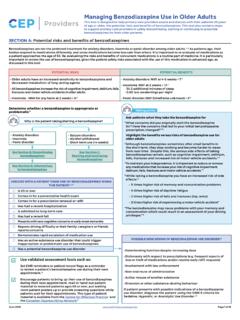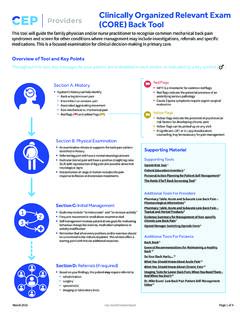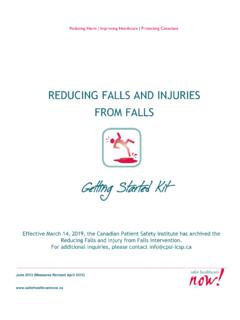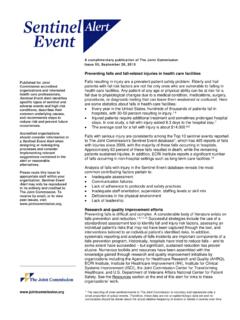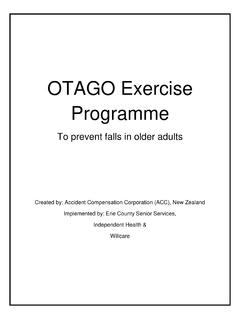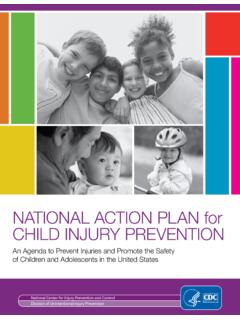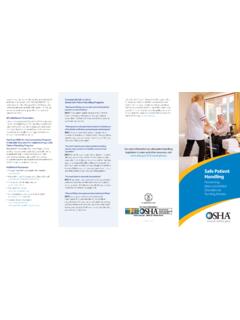Transcription of Falls Prevention Discussion Guide
1 May 2016. Version 1 of 12 Approximately of Ontario residents and of Canadian residents living in LTC have a history of at least one fall in the last 30 days3 Approximately half of all LTC residents will fall at least once per year Recent hospitalization increases the risk of falling In LTC, residents are more likely to fall on the first day after moving into a new room or new unit4 Of those that fall , 40% will fall two or more timesWhy preventing Falls Matters1,2 Long-Term Care (LTC) EditionThis Discussion Guide is designed to help providers assess Falls risk and manage residents in long-term care (LTC) to prevent Falls and the associated co-morbidities. This Guide integrates best-practice evidence, clinical experience, and makes reference to relevant existing tools and services where possible. Important principles include: Being resident-centered Being mindful of benefits, risks and safety concerns Using an inter-professional team approach and validated tools Prescribing conservatively Reassessing regularly for opportunities to deprescribe medications that are no longer neededAs always, efforts must be made to individualize any treatment decisions for the resident, with considerations for caregivers, family and LTC the majority of this Discussion Guide focusses on fall reduction and reducing harm from Falls , it is critical to remember the importance of enhancing resident mobility.
2 The ability to move independently is a cornerstone of resident-centered care, enabling choice and autonomy. LTC home residents should be allowed the freedom to move, even if there are risks involved, and LTC home staff and physicians should strive to provide restorative programs and activities that encourage healthy and safe mobility. Physical restraints should NOT be used to reduce Falls , as research consistently shows increased injuries and further decline when physical restraints are With increasing frailty, and for those at highest risk of fracture, the benefits of continued mobility may begin to be outweighed by other factors and discussions about goals of life and care may shift towards harm reduction, however always encourage as much safe movement as 1. Type of fall -related injury , age 65+, Canada 2009/101 This graph shows that the majority of injuries resulting from a fall were broken or fractured bones (35%) followed by sprains or strains (30%) and scrapes, bruises or blisters (19%).
3 This finding highlights the importance of preventing fall -related injuries among Prevention Discussion GuideMay 2016. Version 2 of 12 Overview of Falls Prevention Discussion GuideSECTION AInitiate Falls AssessmentSECTION BIdentify Risk FactorsSECTION CAct on ResultsConduct a fall assessment using a validated tool in order to tailor interventions to individual risk profiles, and to maximize resources by targeting interventions to those at greatest risk / with a history of section contains recommendations for conducting a fall risk assessment and post- fall more risk factor(s) for Falls , the higher the probability of a fall , however many of these risk factors may be modifiable and therefore when addressed by the care team, can reduce residents risk of section discusses the intrinsic and extrinsic risk factors for falling including those which may be an individualized multi-factorial approach focusing on modifiable non-pharmacological and pharmacological section discusses.
4 4P's Approach BEEEACH checklist Medication review and medications associated with Falls and factures Recommendations for vitamin D with or without calcium Blood pressure Prescribing clinical pearls Anticholinergic burden and risk scales For new admissions After a change in unit or room After any transition or transfer from another care setting After a fall After any change in status After medication change For residents with a history of fallsMay 2016. Version 3 of 12 Pre- fall AssessmentPost- fall AssessmentAssess fall risk in the following situations For new admissions After any transition or transfer from another care setting ( hospital/emergency department, another unit or room, other LTC facility) After a fall After any change in status After medication changes ( adding psychotropics, benzodiazepines, or opioids) For residents with a history of fallsAssess resident s risk of Falls Consider quick screening tools ( Morse fall Scale, Scott fall Risk Screen for Residential Long-Term Care) or in-depth assessment tools ( Resident Assessment Instrument Minimum Data Set (RAI-MDS)6,7,8,9,10 In LTC, where the majority of residents may be at high risk, applying universal precautions for Falls may be more appropriate11 Identify resident s fall risk factors (see Section C))
5 Modify risk factors if appropriateFirst 24 hours12 Rule out severe injury Contact most responsible provider ( attending physician, nurse practitioner) When critical incidents occur, report to MOHLTC and substitute decision maker Evaluate and monitor resident Provide comfort and reassurance Transfer with a mechanical lift if required Investigate and document presence of injury and pain, including:13 Details of the fall Physical examination ( vital signs, sitting and standing blood pressure if possible) Contributing factors ( behaviours, restraint use, bathroom, medications) Environmental context ( location, footwear, floor surface, equipment) Engage with physiotherapist, occupational therapist, other staff, family members; when possible, implement immediate interventionAfter 24 hours Continue to evaluate and monitor for the first 72 hours after a fall Post- fall huddle with relevant interdisciplinary team members and/or most responsible provider Assess resident s risk of fallsSection A: Initiate Falls AssessmentWhy Conduct a fall Assessment?
6 1. To tailor interventions to individual risk profiles2. To maximize resources by targeting interventions to those at greatest risk / with a history of fallsAny unintentional (witnessed or unwitnessed) change in position where the resident ends up on the floor, ground, or other lower fall is considered: When a resident loses balance and a fall would have occurred if staff did not intervene If the fall resulted in an injury If a resident is found on the floor, and staff cannot definitively rule out a fall When the distance to the next lower surface is not a factor ( if a resident rolls onto floor from a mattress placed on the floor, it is still considered a fall )5 How is a fall Defined in Long-Term Care?May 2016. Version 4 of 12 The more risk factor(s) for Falls , the higher the probability of a fall . Many of these risk factors may be modifiable; and therefore, if addressed by the care team, there is the potential to reduce Risk Factors( demographic and biological)Extrinsic Risk Factors( behavioural, environment, and medication related) Age {age > 85, for fall -related mortality}7 Female { for any fracture} Physical conditions Muscle weakness {5} Visual impairment {3} Cognitive impairment {2-5} Foot disorders {2} Transfer independence { } Wheelchair independence { } Low body mass index and weight loss Gait impairment Chronic Medical Conditions Bowel/bladder incontinence and urgency {3} Parkinson s disease { for any fracture and for hip fracture}8,9 Blood pressure Orthostatic hypotension {2} Hypotension Alzheimer s disease {2}10 Diabetes {female.}
7 }11 Arthritis and related pain Cardiovascular disease Chronic obstructive pulmonary disease Depression Obstructive sleep apnea End stage renal disease Stroke Acute illness Restraint use { for fracture or serious injury in LTC} Previous history of Falls {3x risk of fall within the year}12 Medications13 Opioids { for fracture risk, compared to NSAIDS}14 Insulin { } Psychotropics { i n LTC}15 Antidepressants { in LTC} Selective serotonin reuptake inhibitors or serotonin-specific reuptake inhibitors (SSRIs) { } Others {1. 39} Tricyclic antidepressants (TCAs) {1. 30} Combination { } Benzodiazepines { in LTC} Short-acting { 4} Long-acting {1. 32} Antipsychotics {1. 50} Sedatives, hypnotics { in LTC} Anticonvulsants { } ( phenytoin, phenobarbital, carbamazepine) Cardiovascular Vasodilators {3} ( alpha1 receptor blockers, calcium channel blockers, long-acting nitrates, angiotensin converting enzyme inhibitors, and angiotensin I receptor blockers) Anti-arrhythmics {1.
8 59} Digoxin { } Diuretics { } Excessive alcohol Assistive device(s) { 4} Improper footwear or clothing Nutrition and hydration Behaviour Fear of falling decreased sociability possible depression Risk taking behaviour ( not using a walking aid or grab bar when one is needed) Sedentary behaviour Environmental hazards ( high bed, wax floor)LEGENDG reen/italics Potentially modifiable risk factors.{OR} Where possible, odds ratio (OR) provided for the risk of fall unless otherwise noted, and bolded when equal to or greater than example: Restraint use { for fracture or serious injury in LTC} = Residents using restraints has a time increased risk of fracture or serious injury compared to residents who did not use restraints in : Risk factors are based on obser vational evidence where association has been found. Interpretation may be limited due to confounding, especially as many diseases and indicated medications both are associated with fall risk ( is it the worsening disease or the medication that causes Falls ?)
9 Section B: Identify Risk Factors1,4,10,14,15,16,17,18,19,20,21,21 ,22 May 2016. Version 5 of 12 Focus interventions on major contributing modifiable risk factors or causes Use the BEEEACH checklist (see page 6) to select potential interventions to address resident s contributing risk factors, with the aim of reducing their risk of Falls Multifactorial interventions may reduce the risk of Falls , the evidence is inconclusive for single or multiple interventions in LTC23,24,25 Individualize interventions according to resident s needs, goals of care, available family member/caregiver supports and resources Everyone has a role in fall preventionSection C: Act on ResultsKey Concepts4P s Approach29 This approach can be used by nurses, personal care workers, unit managers and other health care professionals to ensure universal fall precautions are in place Consider asking resident about the 4Ps on a regular basis ( after each interaction with resident, one to two times per shift, during rounds, etc.)
10 4P's ApproachPainPositionAre you in pain?Do you have any discomfort?Do you want me to help you move into a better position?PlacementPersonal NeedsDo you need anything to be placed within easy reach?( call bell, phone, reading material)Do you need anything to drink or eat?Do you need to go to the washroom? May 2016. Version 6 of 12 BEEEACH Checklist (Adapted from BEEEACH approach26) Behaviour change and assessment to prevent a fallBehaviour Appropriate assistance when mobilizing and transferring Exercise ( balance, strength, resistance and functional training two to three times per week); take caution in very frail elderly (may increase Falls )25 Individualized toileting schedule Occupational therapy for assistive devices* Physiotherapy for assessment* Restorative therapy/mobility program Turn immobile residents to maintain skin integrityActivity Bed in lowest position Bed, commode locked Contrasting colour behind toilet/toilet seat Declutter resident environment Exits bed toward stronger side Fluorescent tape path to bathroom Improve lighting Move room closer to station Non-glare floor surface Non-slip floor tape Personal items within reach Support resident to get into a comfortable position Review bedrail useEnvironment Appropriate footwear (see safe shoe checklist on page 10) Non-slip socks Review clothing ( easy to put on clothing, not too long)
